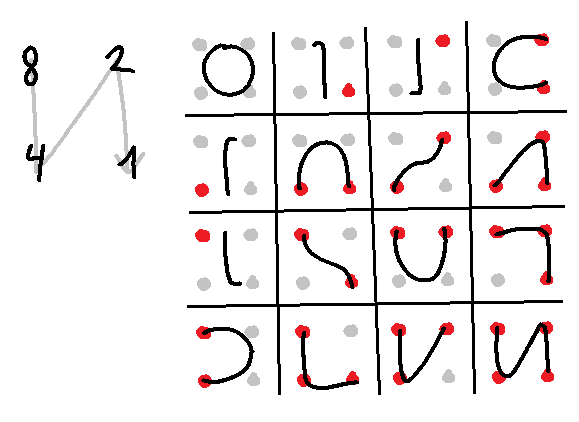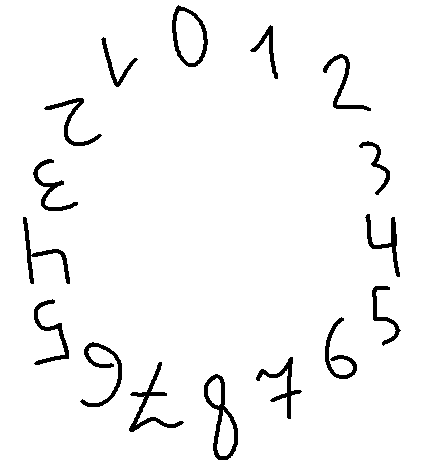Systems of Binary Notation
Before discussing the individual systems, we need to establish some terminology.
- Simple bases have the exact number of digits that the system name indicates, and they are not subdividable into any smaller elements. If grouping is possible, it is allowed to be completely arbitrary.
- Superbases are subdividable into smaller elements that operate according to the base indicated in the name.
- Subbases group smaller elements into larger digits of the base indicated in the name.
For example, using the digits 0 to F is simply hexadecimal notation. But a system that has 4 unique small symbols that it combines in pairs to form 42 unique digits would be subhexadecimal and superquaternary, or subhex-quaternary for short. If no superbase is provided for a subbase, it is assumed to be superbinary.
This page will first cover binary, then subhex, then hexadecimal, then double octal, and then everything else.
Binary systems
Lucillian
Written in vertical lines put next to each other, all “standing” on a single baseline height. Zero is written as a short line, one as a longer line. Bit significance decreases rightwards. Also includes a decimal point (short vertical stroke going below the baseline), a recurring point that signifies the start of a repeating segment (same as decimal point but with a turn to the right), and a left recurring point (orthographically mirrored).
Subhex systems
There is a specific subset of subhex systems that all share the same traits: they have one line as a "base" that shows up in every digit, and four other lines that switch on and off depending on the bits in the digit they represent. I call them the Martin systems, named after Bruce Alan Martin, who proposed the earliest system of this type (namely, the "combs") in 1968.
Here is a diagram illustrating all of them:
Each of the systems is explained in more detail below.
Combs

Proposer: Bruce Alan Martin
Zero is written as a vertical ellipse like its Hindu-Arabic equivalent; all subsequent digits written using four horizontal lines connected by a vertical line to their right, with the bottom line representing the least significant bit.
Runes
Pinecones
Rails
Whitaker's Triangles
Proposer: Ronald O. Witaker
Lorem.
Bibi-Binary

Four bits are placed in corners of a square, going in the direction of the letter И from most to least significant. Digits are written using a line that goes through every 1 bit while following their order.
Hex systems
Hindu-Arabic-Latin (HAL)
Uses either Hindu-Arabic numerals, Latin letters, or a combination of both, whether directly or derivatively.
The “standard” hexadecimal alphabet is 0123456789ABCDEF. Wikipedia lists some other alphabets for notating hex digits that are made of standard alphanumeric characters. This page highlights some attempts that go outside of that set.
Nystrom’s Tonal digits

“Standard” digits 0 to 8 are used, then there are 8 special symbols that are each based on an upside-down version of the HAL digit of the value you’d get if you subtracted that number from hex. Due to an unfortunate coincidence, this forces the symbol 9 (upside-down 6) to signify the number ten.
Tenten

“Standard” digits 0 to 9 are used, then there are 6 special symbols that each attempts to resemble both the letter in standard HAL it corresponds to and the HAL digit of its value minus eight. For example, the digit for ten tries to imitate both A and 2.